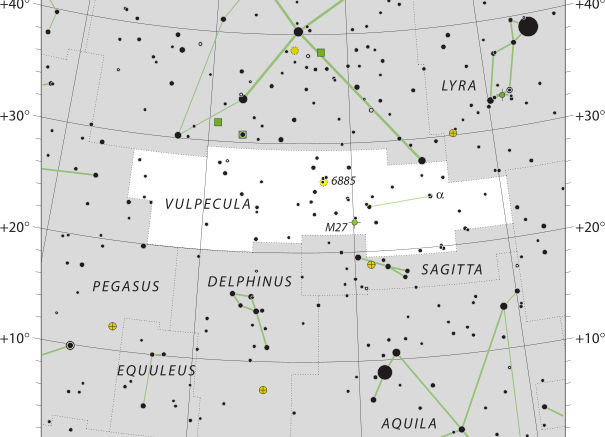The constellation Vulpecula is located in the northern sky, and is very faint. The name of the constellation is Latin for “little fox”, but the name is shortened to ‘the fox.’ There are not any ancient myths associated with the constellation and the constellation is a relatively faint one, as there are no stars brighter than fourth magnitude.
Vulpecula was identified in the 17th century, and is located in the middle of the the Summer Triangle asterism.
Vulpecula is the 55th constellation in size, but has been an area of the sky that has been the area of much scientific discovery. Vulpecula is an area of the sky that astronomers found the first planetary nebula, the Dumbbell Nebula (M27), and the first pulsar ever discovered.
| Applicable Information | |
| Visibility In Pacific Northwest | April to November |
| Best Times To View | August and September |
| Right Ascension | 20h |
| Declination | +25° |
| Area | 268 square degrees |
| Main Stars | 5, 20 |
| Brightest Object | α Vul |
| Meteor showers | N/A-0 |
| Messier objects | 1 |
| Neighboring Constellations | Cygnus, Lyra, Hercules, Sagitta, Delphinus, Pegasus |
History
The late 17th century saw Johannes Hevelius create Vulpecula, which as either Vulpecula cum ansere, “the little fox with the goose”, or Vulpecula et Anser, “the little fox and the goose.” His illustration of the constellation had a goose in the jaws of a fox, as Hevelius regarded the fox and the goose as 1 constellation. The constellation was later separated into the constellations Anser and Vulpecula, but was later merged into 1 constellation. Although the constellation is known as Vulpecula today, the goose is remembered by the name of the star α Vulpeculae or Anser.
Stars
There are no stars brighter than 4th magnitude in this constellation. The brightest star in Vulpecula is Alpha Vulpeculae is a red giant. Using binoculars, the can be split and is an optical binary to observers.
The first pulsar was found by astronomers in this galaxy in 1967.
The only Messier object in the constellation is Messier 27, otherwise known as the Dumbbell Nebula, which is a large, bright planetary nebula discovered in 1764. It was the first planetary nebula to be discovered by astronomers and can be seen with good binoculars in a dark sky location. When viewing the object, it will appear as a dimly glowing disk that is approximately 6 arcminutes in diameter. A telescope will reveal the double-lobed shape, which is similar to the shape of an hourglass.
The Hercules–Corona Borealis Great Wall occupies the eastern segment of Vulpecula, which is a galaxy filament with the length of 3,000 megaparsecs. This means that the Great Wall is the largest structure in the universe.
Make sure to check out other articles on the site, including a brief introduction to constellations, other constellation articles, and more!

Be the first to comment on "Vulpecula"